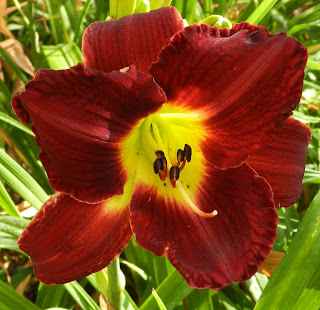This really rain soaked spring and summer have made us
terribly aware of mosquitoes. Ticks are
rampant and the diseases these two bring can be devastating to health. Gnats are swarming like low clouds and even
though they aren’t a huge biting machine, they're certainly pesky. And that brings me to Horse and Deer Flies.
Anyone who has large animals knows these biting insects. And now it seems my yard has become new
“fresh meat” for these stout, broad-headed and brightly eyed flies.
Deer Flies (Chrysops)
live in deciduous and mixed forests, meadows, roadsides and suburbs near water
in all of North America. Yep, that would
be all of us in the Galva News reading area.
The male drinks plant juices and is a pollinator. The larva feeds on small aquatic
insects. Seems good on both counts. And then there’s the lady of the house. Her only meal of choice is the blood from
mammals. Yes, she’s a bloodsucker. In June/July she feasts upon the unsuspecting.
 |
Great Golden Digger Wasp
(good insect) |
Whereas we usually hear mosquitoes, the flight of the deer
fly is mostly silent. They land
stealthily on exposed skin and deliver a painful bite. Their favored place to bite humans is the
neck and face but will bite any exposed skin.
Its mode of attack is to silently circle over it’s intended victim
before settling and it immediately bites.
They can bite repeatedly.
The Horse Fly is a related beast, larger and likes the blood
of large mammals. The wound inflicted
often continues to bleed for several minutes because both of these fly’s saliva
contains an anticoagulant that prevents clotting.
The female doesn’t sting, her bite makes a cross-like
incision and she laps up the resulting blood.
Along with the bite being very painful, some people have an allergic
reaction to the fly’s saliva. People who
are allergic often have increased reactions with each new bite. They may also
carry tularemia, anthrax, loa loa filariasis, several kinds of animal
infections and are suspected carriers of Lyme disease.
In the large mammal industry, their bites are considered to
cause millions in lost revenue, especially in dairy cattle whose milk
production is diminished and weight loss in beef cattle. 20-30 flies feeding six hours on an animal
can take 100 cc of blood. There are specific repellents for specific
animals. Up-to-date advice from your
veterinary is available.
 |
Demoiselle Calopteryx virgo
damselfly (good insect) |
Encourage nest-building wasps, hornets, dragonflies and
killdeer birds because they feast on the flies.
The flies use sight to find prey and may also be attracted
CO or certain odors. Moving objects,
especially dark colored objects are most prone to attack. The first peak biting time is sunrise for
about three hours. The second peak time
is the two hours before sunset. They are
out the least on overcast, windy and cool days.
Heavy shade protection for animals will help.
Since it’s impossible to eliminate their breeding grounds,
especially in this wet weather, protection from bites is the best effort.
Traps are somewhat useful in small-managed areas. Covering yourself with light colored clothing
is suggested. The old fashioned sticky
fly strips hanging from branches or your hat may work but remember they are
VERY sticky to humans also.
Then the one that seems to work if you’re not concerned
about looking like the crazy person next door:
Covering a blue plastic cup or inverted blue plastic mixing bowl in a
liberal coating of petroleum jelly and attaching this contraption to top of
your head. These can also be tied to a string
and hang from tree limbs or to your mower.
The swaying in the breeze seems to attract them and then they stick. They are super attracted to swimming pools
areas.
.JPG) |
Blue Dasher Dragonfly
(good insect) |
Some sources suggest using an insecticide with DEET while
others say it only attracts. For me,
insect spray doesn’t deter the pesky critters.
Covering seems to be my best bet. Netting over your hat and head works
for flies and mosquitos. I recommend the
Bishop Hill pilgrim’s cotton bonnet in a light color. (Several of the B.H. stores carry them.) Mine extends over the back of my neck. Yes, I
seriously look like granny from the Beverly Hillbillies and I’m OK with that if
it means I won’t be bit.
I’m using liberal amounts of pure colorless vanilla. I may smell like a cake but I’m one of those
people who has an allergic reaction and it’s not pretty. Others recommend the oils of garlic,
lavender, peppermint and Eucalyptus. Dab
it on a bandana and tie around your neck, on your hat, or clothing. Some of these may stain clothing or irritate
skin.
With all these recommendations, I expect to see you
gardening in white clothes, a netted hat with a blue SOLO cup died to the top
of it, smelling like a herb oil factory while several fly strips cling to
various parts of your body. Dang I love
gardening for its humor if for nothing else.


.JPG)




.JPG)


.JPG)

.JPG)
.JPG)


.JPG)
.JPG)

.JPG)


.JPG)





.JPG)